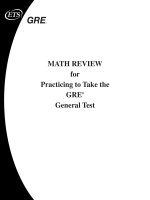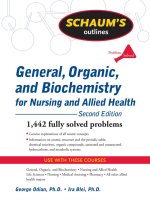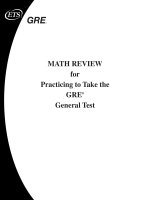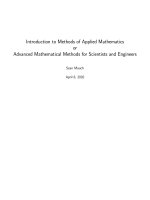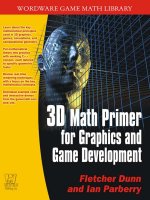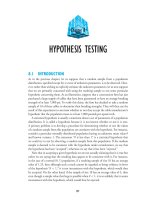Ebook Davis’s basic math review for nursing and health professions (2/E): Part 1
Bạn đang xem bản rút gọn của tài liệu. Xem và tải ngay bản đầy đủ của tài liệu tại đây (6.86 MB, 183 trang )
SECOND EDITION
Davis’s
Basic Math Review
For Nursing and
Health Professions
with Step-by-Step Solutions
5659_ FM_i-xx.indd i
15/11/16 11:59 AM
5659_ FM_i-xx.indd ii
15/11/16 11:59 AM
SECOND EDITION
Davis’s
Basic Math Review
For Nursing and
Health Professions
with Step-by-Step Solutions
Vicki Raines, BS, PTCB
Learning Specialist, Educational Assistance Center
Math Instructor, Adult Education
Temple College
Temple, Texas
5659_ FM_i-xx.indd iii
15/11/16 11:59 AM
F. A. Davis Company
1915 Arch Street
Philadelphia, PA 19103
www.fadavis.com
Copyright © 2017 by F. A. Davis Company
Copyright © 2010, 2017. All rights reserved. This book is protected by copyright. No part of it
may be reproduced, stored in a retrieval system, or transmitted in any form or by any means,
electronic, mechanical, photocopying, recording, or otherwise, without written permission from
the publisher.
Printed in the United States of America
Last digit indicates print number: 10 9 8 7 6 5 4 3 2 1
Senior Acquisitions Editor: Megan Klim
Senior Content Project Manager: Elizabeth Hart
Digital Project Manager: Sandra Glennie
Design and Illustration Manager: Carolyn O’Brien
As new scientific information becomes available through basic and clinical research, recommended treatments and drug therapies undergo changes. The author(s) and publisher have done
everything possible to make this book accurate, up to date, and in accord with accepted
standards at the time of publication. The author(s), editors, and publisher are not responsible for
errors or omissions or for consequences from application of the book, and make no warranty,
expressed or implied, in regard to the contents of the book. Any practice described in this book
should be applied by the reader in accordance with professional standards of care used in regard
to the unique circumstances that may apply in each situation. The reader is advised always to
check product information (package inserts) for changes and new information regarding dose
and contraindications before administering any drug. Caution is especially urged when using
new or infrequently ordered drugs.
Library of Congress Cataloging-in-Publication Data
Names: Raines, Vicki, author.
Title: Davis’s basic math review for nurses : with step-by-step solutions /
Vicki Raines.
Other titles: Basic math review for nurses
Description: 2nd edition. | Philadelphia : F.A. Davis Company, [2017] |
Includes index.
Identifiers: LCCN 2016044725 | ISBN 9780803656598
Subjects: | MESH: Mathematics | Nurses’ Instruction | Problems and Exercises
Classification: LCC RT68 | NLM QA 107.2 | DDC 610.73076—dc23 LC record available at
/>Authorization to photocopy items for internal or personal use, or the internal or personal use of
specific clients, is granted by F. A. Davis Company for users registered with the Copyright Clearance Center (CCC) Transactional Reporting Service, provided that the fee of $.25 per copy is
paid directly to CCC, 222 Rosewood Drive, Danvers, MA 01923. For those organizations that
have been granted a photocopy license by CCC, a separate system of payment has been arranged.
The fee code for users of the Transactional Reporting Service is: 8036-2056-8/09 0 ϩ $.25.
5659_ FM_i-xx.indd iv
15/11/16 11:59 AM
Dedication
Special thanks to Tim, Anne, Samantha, Ed, Charles, Tom, Carol, and Julie
v
5659_ FM_i-xx.indd v
15/11/16 11:59 AM
5659_ FM_i-xx.indd vi
15/11/16 11:59 AM
Sequential Math Skills Method
Identify
knowledge gaps by taking
the pretests.
Focus
your attention on gaps in
skill proficiency.
Review
skills needed to fill gaps by
using step-by-step examples.
Reread
skill
explanation.
Master
skills by working practice
problems.
Skills Not
Mastered
Confirm
skill mastery by taking
a chapter test.
Skills Mastered
Advance
to the next chapter.
All Chapter Tests Mastered
Complete
Sections II and IV
practice tests.
5659_ FM_i-xx.indd vii
15/11/16 11:59 AM
5659_ FM_i-xx.indd viii
15/11/16 11:59 AM
About This Book
Davis’s Basic Math Review for Nursing and Health Professions with Step-byStep Solutions explains the math needed for basic calculations and provides practice problems to help individuals wishing to enter a nursing or
health profession field strengthen their math skills. For prospective students, the book provides an excellent review for the math section of any
nursing or health profession entrance test.
Davis’s Basic Math Review for Nursing and Health Professions with Step-byStep Solutions presents basic skills in a logical mathematical order so users
can easily progress to more advanced skills. For best results, users should
work the practice problems and tests in this book without using a calculator
because calculators are not allowed on many of the entrance tests. The more
practice problems worked, the faster and more accurate computations
become.
Because health care providers often encounter a range of topics requiring math computations—household measures, metric measures, and temperature conversions also are included in this book.
Features of Davis’s Basic Math Review for Nursing and Health Professions with Step-by-Step Solutions:
• A pretest in each chapter helps you determine where to focus your
review. Within each pretest is a section number telling you where to
find an explanation for that particular skill plus practice problems.
• Key Terms are presented in color and are explained in an easy-toread manner.
• Math-skill explanations with example problems are worked step by
step to help you understand the skills required.
• Practice problems help you master each math skill.
• End of chapter tests help you check your progress as you work
through the book.
• Comprehensive practice tests also help you check for mastery of
basic math skills and health care specific applications.
ix
5659_ FM_i-xx.indd ix
15/11/16 11:59 AM
• Step-by-step solutions for all pretests, practice problems, chapter
tests, and cumulative practice tests help you identify your mistakes
and see how to correct your work.
• Test-Taking Tips will help you learn how to make the most of your
math knowledge and reduce your test-taking anxiety.
For best results with Davis’s Basic Math Review for Nursing and Health
Professions with Step-by-Step Solutions, complete the entire review regardless of your math-skill level. By doing so, you can enhance speed and
accuracy in your math computations.
x
About This Book
5659_ FM_i-xx.indd x
15/11/16 11:59 AM
Tips for Taking
a Math Test
These tips are divided into three parts: studying for a math test, taking a
math test on paper, and taking a standardized math test on a computer. For
best test-taking success, follow all suggestions carefully.
Studying for a Math Test
1.
2.
3.
4.
5.
6.
Solve all the practice problems, and check your answers for
accuracy.
Write down and memorize any skill rules the test covers.
Review the problems to be covered on the test. Rework several of
each type of problem.
Review the instructions for the problems. Be sure you understand
the wording of the instructions.
Complete additional problems or a practice test.
Put down your pencil, and work through the review in your mind.
Look at each problem, and be sure you know the first step in solving that type of problem. Usually, if you know the first step, you can
complete the problem.
Taking a Math Test on Paper
1.
2.
3.
4.
5.
6.
As soon as you receive the test, jot down the rules you have
memorized.
Glance at the problems on the test. A quick scan will tell you which
problems may require the most time.
Go back to the first problem and start working.
If you are unable to solve a problem, write the problem’s number at
the top of the page and move on. Something later in the test may
trigger a solution for the troublesome problem.
Continue working problems and writing the number of each troublesome problem at the top of the page.
After attempting all of the problems once, go back, and start working the problem(s) listed at the top of each page. If you see your
mistake immediately, fix it, and finish solving the problem. But do
xi
5659_ FM_i-xx.indd xi
15/11/16 11:59 AM
not spend time trying to find a mistake. Instead, rewrite the problem on another piece of paper, and start over.
7. Repeat Step 6 until time is up or until you have completed the test.
Preparing for a Standardized Math Test
Ask Questions: Before taking any standardized test, determine the
answers to these questions.
• Do blank answers count against your score? If so, then making an
educated guess is better than leaving any answers blank.
• How many problems are on the test and what is the time limit? By
knowing the number of problems and the time limit, you can determine how quickly you will need to work each problem.
• Are you allowed to go back and rework problems if you are taking
the test on a computer?
• Are you allowed to use a calculator?
Minimize Distraction, Maximize Concentration: Some
testing environments are noisy, and earplugs may be beneficial. If you decide
to use earplugs—buy, wear, and get used to them long before the test day.
Taking a Standardized Math Test on a Computer
1.
2.
3.
4.
5.
6.
xii
After sitting down at the testing computer, arrange your paper and
workspace so that you can work comfortably. Place the mouse in a
comfortable, useable position.
Ask the test proctor any questions that you have about the
computer.
Read all of the test instructions carefully.
Before beginning the test, write TIME and GO BACK (if the test
allows you to go back and rework problems) on your scratch
paper.
Write your starting time under TIME so you can estimate your
working rate and stay aware of the remaining time. Some test
screens do not provide time remaining information.
Write the problems down neatly and quickly. Solve quickly. If your
answer is not a choice, glance at the monitor to be sure you copied
the problem correctly. Quickly scan your work for an error. If it is
better to make an educated guess on the test, then make one. You
Tips for Taking a Math Test
5659_ FM_i-xx.indd xii
15/11/16 11:59 AM
might run out of time and not get the opportunity to go back and
rework the problem. Write the problem number under GO BACK.
7. If you finish working all the problems before the time is up, stop
before submitting your answers. This is the time to rework the
problems on your GO-BACK list.
8. To use your time most efficiently, go back to the highest number
(the problem you most recently worked) on your GO-BACK list.
Then work back to the lowest number if time allows.
Tips for Taking a Math Test xiii
5659_ FM_i-xx.indd xiii
15/11/16 11:59 AM
5659_ FM_i-xx.indd xiv
15/11/16 11:59 AM
Contents
part I
Basic Math Skills
1
Whole Numbers
1
1.0
Pretest for Whole Numbers
1
1.1
Adding Whole Numbers
2
1.2
Subtracting Whole Numbers
4
1.3
Multiplying Whole Numbers
1.4
Dividing Whole Numbers
10
1.5
Chapter Test for Whole Numbers
15
chapter
1
6
Fractions
17
2.0
Pretest for Fractions
17
2.1
Fraction Terminology
18
2.2
Multiplying Fractions
24
chapter 2
2.3
Dividing Fractions
30
2.4
Finding the Least Common Denominator (LCD)
35
2.5
Adding Fractions
40
2.6
Subtracting Fractions
46
2.7
Chapter Test for Fractions
55
Decimal Numbers
57
3.0
Pretest for Decimal Numbers
57
3.1
Place Value
58
3.2
Rounding Decimal Numbers
61
3.3
Adding and Subtracting Decimal Numbers
64
3.4
Multiplying Decimal Numbers
68
3.5
Dividing Decimal Numbers
72
3.6
Converting Decimal Numbers and Fractions
77
3.7
Comparing Decimal Numbers and Fractions
81
3.8
Chapter Test for Decimal Numbers
85
chapter 3
xv
5659_ FM_i-xx.indd xv
15/11/16 11:59 AM
Percents, Ratios, and Proportions
87
4.0
Pretest for Percents, Ratios, and Proportions
87
4.1
Ratios and Proportions
88
4.2
The Percent Proportion
93
4.3
Fractions, Ratios, and Percents
100
4.4
Working with Percents and Decimal Numbers
105
4.5
Fraction, Decimal, and Percent Table
110
4.6
Chapter Test for Percents, Ratios, and Proportions
113
chapter
chapter
4
5
Positive and Negative Numbers
5.0
Pretest for Positive and Negative Numbers
115
5.1
Adding Positive and Negative Numbers
116
5.2
Subtracting Positive and Negative Numbers
120
5.3
Multiplying and Dividing Positive
and Negative Numbers
124
5.4
Collecting Like Terms
127
5.5
The Distributive Property
132
5.6
Chapter Test for Positive and Negative Numbers
135
chapter
6
Equations
137
6.0
Pretest for Equations
6.1
Solving Equations with Addition and Subtraction
138
6.2
Solving Equations by Multiplying and Dividing
142
6.3
Solving Two-Step Equations
148
6.4
Solving Equations When a Variable
Occurs Multiple Times
155
6.5
Chapter Test for Equations
165
part II Practice Tests for Basic Math Skills
xvi
115
137
167
practice test
1
Cumulative Skills Test
167
practice test
2
Combined Skills Test
172
Contents
5659_ FM_i-xx.indd xvi
15/11/16 11:59 AM
part III Measures Used in Health Care
Applications
175
7
175
chapter
Household Measures
7.0
Pretest for Household Measures
175
7.1
Household Measures for Length
176
7.2
Household Measures for Weight
180
7.3
Household Measures for Volume
184
7.4
Chapter Test for Household Measures
189
chapter
8
191
The Metric System
8.0
Pretest for the Metric System
191
8.1
Multiplication and Division by Powers of 10
192
8.2
Metric System Basics
197
8.3
Metric Units Used in Nursing
201
8.4
Converting Units in the Metric System
205
8.5
Chapter Test for the Metric System
211
part IV Practice Tests for Measures
practice test
practice test
1
2
213
Basic Unit Conversions for Household
and Metric Measures
213
Performing Household
and Metric Conversions
215
219
Step-by-Step Solutions
appendix
A: Roman Numerals
327
appendix
B: Temperature Conversions
329
Index
335
Contents
5659_ FM_i-xx.indd xvii
xvii
15/11/16 11:59 AM
part
Basic Math Skills
chapter
1
I
Whole Numbers
1.0
1.1
1.2
1.3
1.4
1.5
Pretest for Whole
Adding Whole
Subtracting Whole
Multiplying Whole
Dividing Whole
Chapter Test for Whole
1.0
Numbers
Numbers
Numbers
Numbers
Numbers
Numbers
Pretest for Whole Numbers
Solve the following problems. After taking the test, see “Step-by-Step Solutions” for the answers (page 219). Then, see “1.1 Adding Whole Numbers,”
“1.2 Subtracting Whole Numbers,” “1.3 Multiplying Whole Numbers,” and
“1.4 Dividing Whole Numbers,” for skill explanations.
Section 1.1
Section 1.2
Section 1.3
Section 1.4
1.
5,057
+ 8,876
3.
4,632
− 743
5.
578
× 9
Write your answer with
a remainder if needed.
2.
12,672
+ 9,458
4.
71,043
− 68,736
6.
625
× 79
7.
645
× 708
8. 17)759
9. 15)8,080
10. 236)10, 400
1
2056_01_001-016.indd 1
11/5/09 11:41:47 AM
1.1
Adding Whole Numbers
In this section, we will review:
• addition terminology
• an easy format for problem-solving
• carrying numbers
Addition Terminology
In addition, the numbers to be added are called addends. The answer is
called the sum.
addend
+ addend
sum
Before adding whole numbers, write the problem vertically (up and
down), lining up the numbers in the far right column. The columns must
line up for the answer to be correct.
437 + 42 should be written as
437
+ 42
before beginning to add.
Always start adding with the far right column (the ones’ column), and
then move left to the next column (the tens’ column). Continue until you
have added all columns.
Carrying Numbers
In math, we use a base 10-place value system. Therefore, if you have a sum
of 10 or greater in any column, you must carry a number to the top of the
next column to the left. Then, you add the carried number to the numbers
in that column. The following examples show you how to carry.
Example 1: 54 + 38
STEP 1. Add 4 + 8. The sum is 12. Write 2 below the
8. Carry the 1. (Write 1 above the 5.)
STEP 2. Add 1 + 5 + 3. The sum is 9. Write 9 to the
left of the 2.
The answer is 92.
2
1
54
+ 38
92
part 1 Basic Math Skills
2056_01_001-016.indd 2
11/5/09 11:41:54 AM
Example 2: 476 + 367 + 458
STEP 1. Add 6 + 7 + 8. The sum is 21. Write 1 below
the 8. Carry the 2. (Write 2 above the 7.)
STEP 2. Add 2 + 7 + 6 + 5. The sum is 20. Write 0
below the 5. Carry the 2. (Write 2 above the 4.)
STEP 3. Add 2 + 4 + 3 + 4. The sum is 13. Write 13
to the left of the 0.
The answer is 1,301.
22
476
367
+ 458
1,301
1.1 Practice Adding Whole Numbers
Solve the following problems. See “Step-by-Step Solutions” (pages 219 to 220) for the answers.
1.
408
+ 241
2.
523
+ 271
3.
405
+ 561
4.
216
+ 423
5.
640
+ 118
6.
7,244
+ 2,786
7.
8,563
+ 4,567
8.
5,042
+ 1966
,
9.
5,787
+ 2,344
10.
3,329
+ 4,783
11.
4,815
+ 6,396
12.
7,586
+ 1645
,
13.
4,116
+ 3168
,
14.
7121
,
+ 2,850
15.
2,351
+ 7,499
16.
4,386
3,798
+ 1745
,
17.
7,038
,
1056
+ 2,784
18.
6,748
5,902
+ 4,352
19.
8,764
9,989
+ 6,478
20.
2,697
7,507
+ 4,572
chapter 1
2056_01_001-016.indd 3
Whole Numbers 3
11/5/09 11:41:55 AM
1.2
Subtracting Whole Numbers
In this section, we will review:
• subtraction terminology
• an easy format for problem-solving
• borrowing numbers
Subtraction Terminology
In subtraction, the larger number is called the minuend, the smaller number (or the number being subtracted) is called the subtrahend, and the
answer is called the difference.
minuend
- subtrahend
difference
An Easy Format for Problem-Solving
Subtraction is the inverse (opposite) of addition because you take away
numbers, and your answer is always smaller than the original number.
If you know your addition facts, then you know your subtraction
facts.
The first step in a subtraction problem is to write the numbers vertically
(up and down) with the larger number at the top. Line up the numbers on
the far right as you do when adding. As in addition, always start working
subtraction problems in the far right column. Easy subtraction involves
using basic subtraction facts.
Example 1: 37 − 25
STEP 1. Subtract 5 from 7. Write 2 below the 5.
STEP 2. Subtract 2 from 3. Write 1 to the left of the 2.
The answer is 12.
37
- 25
12
Borrowing Numbers
In some subtraction problems, the bottom number in a column may be
greater than the top number. When this happens, you must borrow from
a column to the left to make the top number larger. Borrowing several times
in one subtraction problem may be necessary as shown in Example 3.
4
part 1 Basic Math Skills
2056_01_001-016.indd 4
11/5/09 11:41:56 AM
Example 2: 546 − 18
STEP 1. Observe that you cannot subtract 8 from 6.
Therefore, you must borrow a 1 from the
column to the left of the 6. Cross out the 4 and
write a 3 above it. Write 1 in front of the 6 to
form 16. Reason: When you borrow a 1 from
the 4 in the column to the left of the 6, you
actually borrow a 10 (from the tens’ column).
STEP 2. Subtract 8 from 16. Write 8 below the 8.
Subtract the next column to the left:
3 − 1 = 2. Write 2 below the 1.
STEP 3. Bring down the 5; no number is below it to
subtract.
The answer is 528.
316
546
- 18
528
Borrowing from Zero
When a subtraction problem has a zero in the top number, you must borrow unless a zero is directly under it. Keep borrowing until you can subtract. See Example 3.
Example 3: 406 − 159
STEP 1. Determine if you can subtract the number in
the far right column. Because you cannot
subtract 9 from 6, look one column to the left.
The digit to the left of 6 is 0. You cannot
borrow from 0. Look to the next number to
the left, the 4.
STEP 2. Borrow 1 from the 4. Cross out the 4, and
write a 3 above it. Write 1 in front of the 0
(or write 10 above the 0 as shown). Now,
the 0 becomes 10.
STEP 3. Look at the far right column again. You still
cannot subtract 9 from 6. However, now you can
borrow 1 from 10. Cross out the 10 and write a 9
above it. Write a 1 in front of the 6 (or write 16
above the 6 as shown). Now the 6 becomes 16
and you can subtract 9 from 16.
STEP 4. Subtract 9 from 16. Write 7 below the 9.
Subtract the next column to the left: 9 − 5 = 4.
Write 4 below the 5. Subtract the next column
to the left: 3 − 1 = 2. Write 2 below the 1.
The answer is 247.
You will need to
borrow twice in this
problem.
The first time you
borrow:
3 10
406
- 159
The second time you
borrow:
4 06
-15 9
247
chapter 1
2056_01_001-016.indd 5
9 16
310
Whole Numbers 5
11/5/09 11:41:57 AM
1.2
Practice Subtracting Whole Numbers
Solve the following problems. See “Step-by-Step Solutions” (pages 220 to 221) for the answers.
1.
7,642
− 4,210
2.
8,235
− 3123
,
3.
174
− 48
4.
347
− 129
5.
692
− 217
6.
7,843
− 6,274
7.
4,376
− 2,808
8.
3,275
− 1744
,
9.
3,456
− 2,738
10.
3,010
− 2,563
11.
7133
,
− 2,924
12.
5,301
− 3,466
13.
2,007
− 347
14.
6,231
− 430
15.
5,005
− 4,835
16.
9,112
− 2,569
17.
6,002
− 3,574
18.
8,303
− 1, 227
19.
9,041
− 2,961
20.
4,000
− 2,564
1.3
Multiplying Whole Numbers
In this section, we will review:
• multiplication terminology
• an easy format for problem solving
• partial products
• multiplying by zero
Multiplication Terminology
In multiplication, a multiplicand and a multiplier are multiplied to find
a product (the answer). Sometimes, the multiplicand and multiplier are
both called factors. You will see the latter term used in nursing-specific
applications.
multiplicand
x multiplier
product
The first step in solving a multiplication problem is to write the problem vertically (up and down) as shown, placing the longer number
6
part 1 Basic Math Skills
2056_01_001-016.indd 6
11/5/09 11:41:58 AM
above the shorter number. Line up the numbers in the right-hand
column.
476 x 54
476
x 54
Partial Products
Multiplication problems with more than one digit in the multiplier create
partial products. Then you add the partial products to get the final answer,
the product. Carrying also may be required when multiplying as shown.
1
24
x 13
172 partial product
24 partial product
312 producct
Example 1: 546 × 32
STEP 1. Multiply 546 by 2, multiplying from right to left:
2 × 6 = 12. Write a 2 on the first partial product
line and carry a 1. Place the 1 over the 4. Next,
multiply: 2 × 4 = 8; add the 1 carried to the 8 to
get 9. Write the 9 to the left of the 2. Next,
multiply: 2 × 5 = 10. Write 10 to the left of the 9.
1092 is a partial product.
In Step 2, write the second partial product on the line
below 1092. Note that you move over one place to the
left to start writing this partial product because the 3
you are multiplying by is in the tens’ place. (See Section
3.1, Place Value, page 58.)
STEP 2. Multiply 546 by 3 (the number to the left of the
factor 2), multiplying from right to left:
3 × 6 = 18. Write the 8 below the 9 on the first
partial product line, and carry the 1. Place the 1
over the 4. Next, multiply: 3 × 4 = 12. Add the 1
carried to the 12 to get 13. Write the 3 to the left
of the 8, and carry the 1. Next, multiply: 3 × 5 =
15. Add the 1 carried to the 15 to get 16. Write
16 to the left of the 3.
11
1
546
x 32
1
1092
1638
17,472
STEP 3. Add the partial products.
The answer is 17,472.
chapter 1
2056_01_001-016.indd 7
Whole Numbers 7
11/5/09 11:41:59 AM
